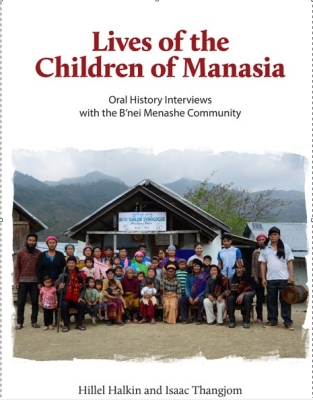Lives of the Children of Manasia - Book Review
Lives of the Children of Manasia
by Hillel Halkin and Isaac Thangjom
Paperback; 376 pages
Gefen Publishing House
Price: $24.95
Reviewed by R.M. Kiel
In this book, Halkin and Thangjom present interviews from a group of 12 people from the Bnei Menashe Community. The interviews are fascinating and moving.
First, I looked at the map on page 321, which somewhat confused me. I am an avid map reader. Why was I confused? I decided that the direction of the large arrow should be
reversed. Having settled that, I turned to the excellent introduction – a must read.
The introduction explains how many of the children of the Bnei Menashe started life in traditional, partly, or wholly pre-Christian villages; went through a time of devout Christian faith; found themselves troubled by certain aspects of this faith and finally turned to Judaism. Many emigrated to Israel, where 5000 members now live as full Jews and as Israeli citizens.
The break between followers of Rabbi Avichail and his Amishav organization and that of Shavei Israel led by Michael Freund is mentioned. We also read that some interviewees had difficulty in putting their private lives on display. They had been brought up to think that doing so was exhibitionist. They described encounters with the supernatural. The editors understood that they were told things by people whose concept of reality was different from that of the editors.
The Bnei Menashe Community ranges from the elderly to the newborn. Some were able to speak about the experiences of their antecedents that took place during World War I; others of the Japanese invasion of 1944; others of World War II in general. They speak about the rifts that occurred between Ashkenazi and Sephardi promoters of Judaism who visited from Israel.
On arriving in Israel some Bnei Menashe members were settled in Gush Katif, others in Afula; some moved north, others went south. Overall, though, they put down roots with other Bnei Menashe families. However, once in Israel, they experienced a drastic change in life style. A number mention the loss of respect for the older generation. Their
children growing up in Israel feel that being obedient is seen as not being Jewish. You must stand up for yourself, speak out and be heard. Religion is not a priority for the young.
Many of the villages left behind in India by the Community were surrounded by jungle. There were wolves, bears, wild boar, deer, wild goats, and at least one python, which enjoyed the performances it gave to the local villagers.
People grew rice, corn, cucumber and chili. They had goats and cows. They lived frequently together with their animals, at night keeping them under the houses, which were often on stilts. They did not have to worry about theft.Villages had chiefs, who usually had two helpers, to administer local affairs.
In Israel it takes less effort to be Jewish. The Community found that their children want smartphones. They are clever, but they do not learn to be wise.
The interviewees had been involved in various ways of earning a living, the main occupations being agriculture and tending flocks and herds. One or two went in for smuggling opium and diamonds. One or two did brief prison spells. All were much involved with a nearby religious group, usually some sort of Christian groupt, before turning to Judaism.
In Israel, Shlomo Gangte found himself in the middle of a gunfight with an Arab terrorist, whom he fought by using his fists!
The book is well-produced, with clear easy-to-read print. One complaint: the final book of the Christian testament is singular - Revelation – never plural.
This is not a book to read at one sitting. Linger over the interviews and give yourself time to appreciate and to learn from each one.








Comments